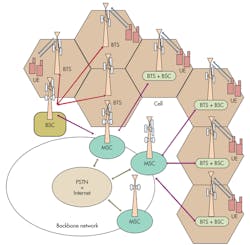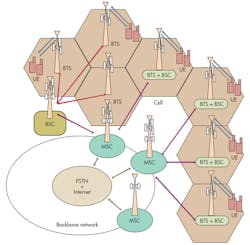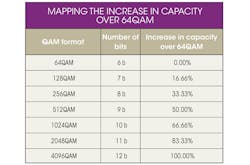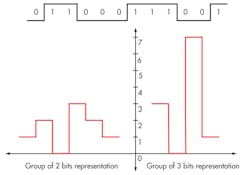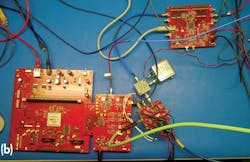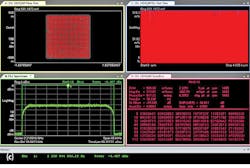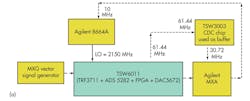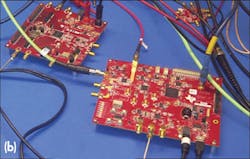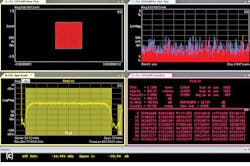Download this article in .PDF format
Demands on high-speed wireless systems have grown with the increasing numbers of smartphone users and their devices’ many functions, including wireless Internet access. As the capacities of global wireless-communications standards, such as Third-Generation (3G) cellular and Fourth-Generation (4G) Long-Term-Evolution (LTE) cellular technologies are increased, demands are created for wider available bandwidths and higher modulation rates.
Related Articles
• Five Trends Shaping 802.11 WLANs
• Low-Cost Front End Receives 9 GHz
• Interview: Amir Eliaz, Co-Founder and CTO, MagnaCom
Microwave backhaul systems now call for modulation levels to 1024-state quadrature amplitude modulation (1024QAM) and beyond. Such complex modulation schemes impose increased challenges at the system levels, both for transmitters and receivers. Due to the increased number of symbols, the systems require higher signal-to-noise ratios (SNRs) along with better linearity.
Cellular technologies and applications have grown steadily from the basic analog systems of First-Generation (1G) cellular standards to the high-speed and highly efficient 4G Third-Generation-Partnership-Program (3GPP) and LTE digital cellular standards. Many cellular markets are already eying the use of Fifth-Generation (5G) cellular systems and technologies.
Cellular and base-station systems must meet demands for the rapidly growing number of cell phone users, from making to routing calls; from secure data transfers to high-speed data downloading; and from efficient use of available frequency spectrum to handling multiple users at a time. These advancements and requirements have increased the capacity demand for base-station network equipment.
Numerous techniques have been introduced to effectively and efficiently use the available spectrum. More and more users are demanding access to high-speed data, so wireless operators require increased-capacity networks with higher-modulation-rate support capability. Base-station networks supporting microwave backhaul applications and operating at frequencies in the range of 6 to 42 GHz send data from numerous users to the central backbone network.
This data is an order of magnitude more than from one user or from one sector of users, requiring support capability at higher modulation levels. Low-noise and high-performance wireless infrastructure signal-chain solutions are available which are suitable for such emerging high-modulation requirements.
Figure 1 shows a simplified view of a cellular network, along with the central backbone network. Generally, it consists of a base transceiver station (BTS), base station controller (BSC), mobile switching center (MSC), and landline linked public switched telephone network (PSTN). User equipment (UE) or cellular telephones communicate directly with the BTS. The BTS is linked to a BSC, either via cable or wirelessly by means of microwave links.
The BTS and BSC are usually collocated, though occasionally a small number of BTS units are controlled by one BSC. The MSC is linked to the BSC. The MSC connects cells to a wide area network (WAN), manages call setup, implements call hand-over, and performs many more network operations. MSCs are also linked to the PSTN for landline calls and Internet access.
All BTS units are generally connected to a backbone network through MSCs. Backhaul functionality, which comprises this central backbone network, uses either wired communications, fiber-optic communications links, or microwave links. Fiber-optic links provide tremendous capacity, but require physical installation and can take more time to deploy than other wireless communications links. Also making them less desirable is the fact they are expensive, since land is required for hosting the link hardware, which must be rented or purchased. In addition, fiber-optic links necessitate digging the land to lay the fiber-optic line.
Microwave links, which are more easily and quickly deployed, are traditionally preferred for a cellular network. These links require line-of-sight communications transmission and are susceptible to the effects of atmospheric conditions, such as rainfall attenuation and fog.
Microwave backhaul links commonly use quadrature amplitude modulation (QAM) digital modulation.1 QAM is a highly developed digital modulation scheme where both the amplitude and phase of a high-frequency signal are modulated. The 2N QAM level represents n bits/symbol. For example, 6 b/symbol represents 64QAM, and 12 b/symbol represents 4096QAM. Thus, in 64QAM, each symbol represents 6 b of information, whereas in 4096QAM, one symbol represents 12 b of information (see table).
Quite simply, higher QAM levels deliver higher capacity. The increase in capacity from a lower bit (nl) per symbol QAM level to a higher bit (nh) per symbol QAM level is given by Eq. 1. For example, an increase of 100% in system capacity occurs for a switch from 6-b 64QAM to 12-b 4096QAM1:
Increase in capacity (%) = [(nh – nl)/nl] × 100 (1)
A Closer Look
Figure 2 shows a group of 2- and 3-b representations of a digital sequence. Larger numbers of bit grouping (equivalent to higher modulation levels) have more amplitude levels. Thus, for fixed average power, higher-modulation-level signals will have relatively larger peak levels or higher peak-to-average-ratio (PAR) values. Higher PAR requires better linearity to maintain a required bit error rate (BER), signal integrity, and other performance parameters.
As the number of amplitude levels is increased, the signals with larger modulation levels are more susceptible to noise. Thus, a system with higher SNR or better noise floor is desired and an oscillator with superior phase noise is required to achieve low system noise levels and minimum signal degradation.
Given the symbol rate, fs, of a QAM signal, the approximate RF bandwidth (BW) can be estimated by applying Eq. 2:
BW = fl(1 + α) (2)
where:
α = the filter rolloff factor.
Generally, a raised-cosine filter is used for pulse-shaping in digital systems as it provides lower intersymbol interference (ISI) and the rolloff factor of the raised-cosine filter determines the excess bandwidth the filter occupies beyond the Nyquist bandwidth (fs/2).
Measuring the performance of link quality in the presence of impairments such as phase noise, system thermal noise, and clock jitter can be described in terms of error-vector-magnitude (EVM) measurements. In the case of direct-conversion modulators and demodulators, additional impairments exist such as local-oscillator (LO) leakage in transmitters, DC offset in receivers, and in-phase/quadrature (I/Q) magnitude and phase imbalance. EVM measurements evaluate the difference between actual and ideal symbol locations of a digitally modulated waveform.
EVM is related to the system’s SNR. An ideal system with zero noise, no nonlinearity distortion, no frequency error, and no I/Q imbalance will have an excellent (theoretically infinite) SNR and zero EVM. Degradation in EVM is due to longer error distance between the referenced and measured symbol locations, which is due to system noise and distortion.
Texas Instruments has developed a wide variety of highly linear and high-performance signal-chain devices suitable for large-bandwidth, high-modulation-rate requirements. For example, model TRF3720, is a fully integrated I/Q modulator and phase-locked-loop (PLL) voltage-controlled oscillator (VCO) which exhibits a 1024QAM EVM of 0.589%. Figure 3(a) shows an evaluation setup for the device, where a model TSW3100 pattern generator is used as the baseband signal source.
The digital-to-analog converter (DAC) in this test setup is a model DAC34H84, which is cascaded with the TRF3720 device under test. The evaluation system was locked to a low-noise 61.44-MHz reference oscillator, with a model TSW3003 evaluation board used as a buffer to divide the 61.44-MHz reference clock to 30.72 MHz to lock the instruments. Figure 3(b) shows the evaluation setup with the modulator, DAC, pattern generator, and signal splitter. Figure 3(c) shows the 56-MHz 1024QAM signal EVM of 0.589% at the modulated output centered at 2.21 GHz.
Summing Up
For demodulation purposes, the model TRF3711 demodulator is a highly linear, direct frequency downconverter that integrates balanced I and Q mixers, a programmable lowpass filter, programmable gain amplifier, LO buffers, and phase splitters. It is a quadrature demodulator capable of converting RF signals directly to complex baseband signals, and it exhibits a 1024QAM EVM of 1.1%.Related Articles
• Five Trends Shaping 802.11 WLANs
• Low-Cost Front End Receives 9 GHz
• Interview: Amir Eliaz, Co-Founder and CTO, MagnaCom
Figure 4(a) shows an experimental test setup with a single receive channel reference design (model TSW6011) with frequency downconversion demodulator, octal model ADS5282 analog-to-digital converter (ADC), and DAC. Figure 4(b) shows the test setup, while Fig. 4(c) shows the 1.1% 56-MHz 1024QAM signal EVM at the cascaded output of the TRF3711 + ADS5282 + DAC5672.
These higher modulation rates grow in importance as wireless communications users increase their use of wireless services for voice, data, and video. To keep pace, wireless systems must use higher QAM levels in base-station backhaul networks operating at microwave frequencies. Higher modulation levels impose increased system challenges, since they are more susceptible to the effects of noise. Fortunately, modern modulator and signal-generation products provide the low noise levels needed—at the higher frequencies required—to support more complex modulation formats and wider-bandwidth applications.
Dr. Habeeb Ur Rahman Mohammed, Applications Engineer, High-Speed Products
Texas Instruments, Inc., 12500 TI Blvd., Dallas, TX 75243; (972) 995-2011
References
1. E. Nesse, “Boosting Long-haul Microwave Capacity with 1024QAM,” EE Times, March 2012.
2. TI Integrated IQ Modulator PLL/VCOs: SLWS224, TRF372017.
